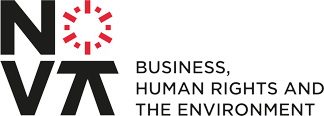This blog post is based on the interventions of Catarina Fernandes Alves in the webinar on Corporate Due Diligence and Capital Markets organised as part of the First Annual Conference of the Nova Centre on Business, Human Rights and the Environment with the support of PLMJ, the Portuguese Chamber of Commerce and Industry, CEDIS, as well as NOVA 4 The Globe on the 25th of November 2021.
About the author: Catarina Fernandes Alves is a corporate sustainability and sustainable finance professional at the consulting firm Systemic, and one of the co-founders of the young-led association LIDERA. She believes that the financial system has a key role in solving world’s social and environmental problems – “We change financial practices and goals, and we change the world”, she states.
Catarina, can you tell us a bit more about yourself and your work?
“Sustainability” became a part of my life during my bachelor’s degree in management, first through volunteer work and then through environmental economics classes. In environmental economics, it became evident to me that, despite all of the positive outcomes it has produced over the previous 100 years, our economic system is based on an economic model designed for the short run – just consider how most “long term” economic and corporate plans are only made for 5 years. This prompted me to study a master’s degree in Sustainability Leadership in Sweden, and later to do an executive course in sustainable finance.
I began working in Systemic in Corporate Sustainability and Sustainable Finance in 2020. At Systemic we help organizations to think about the future, to imagine it, to set up their ambitions and to implement a set of concrete actions towards sustainable development: green, circular, carbon-neutral, inclusive, and just. We work with a wide range of financial and non-financial players, public entities, and non-profits to help them understand and adapt to new and upcoming sustainability and sustainable finance regulations and market shifts. For example, we are currently working with an international organization, assisting them in the development of workshops for credit rating agencies, investors, and large companies from various sectors that promote the integration of ESG factors in global credit risk assessment.
Why is sustainable finance gaining ground and why is it so important?
Financial institutions have a large influence in shaping tomorrow’s world — To a large extent, the money we invest today determines the future. That is why it is critical to develop the appropriate mechanisms to align financial practices with sustainability. If financial institutions prioritize sustainable investments, businesses will shift to sustainable business models, and people will have greater access to sustainable consumption and lifestyle options as a result.
Until recently, most capital market Corporate Due Diligence on environmental issues was strictly limited to a few financial material areas, such as environmental and human rights basic law compliance and reputational issues. Nonetheless, things appear to be changing. Nations that have signed the Paris Agreement and the Sustainable Development Goals recognize that public funds alone will not be sufficient to effect the necessary systemic change. To combat climate change alone, we will require trillions of dollars. If the financial system is not aligned with these social and environmental goals, no matter what changes we make, money will likely flow to the wrong activities – especially because mainstream polluting companies/solutions appear less risky in the short term than breakthrough technologies that could help us solve sustainability problems.
To make this change happen, we are seeing some of the world’s most powerful governments creating regulation that will increasingly force financial institutions to address the financial risks of sustainability issues and the social and environmental impacts of their investments. Furthermore, because the financial risks of sustainable issues, such as climate change, are more evident than ever, private-led initiatives like the Task Force on Climate-Related Financial Disclosures (TCFD) are growing and pushing forward the sustainable finance agenda.
What impact can the EU Taxonomy Regulation and the Sustainable Finance Disclosure Regulation (SFDR) have on sustainability?
Simple answer: At its full potential, it can transform financial markets into main drivers of sustainability.
The EU has created a new Sustainable Finance Package, which includes a set of regulations to align financial institutions with the EU’s six priority environmental goals: (1) climate change mitigation, (2) climate change adaptation, (3) sustainable use and protection of water and marine resources, (4) transition to a circular economy, (5) pollution prevention and control, and (6) protection and restoration of biodiversity and ecosystems.
The EU Taxonomy is the regulation that serves as the foundation for most of the work: a classification system that determines whether a sector-specific economic activity is environmentally sustainable or not. According to the regulation, a sustainable economic activity must contribute significantly to at least one of the 6 EU environmental objectives without jeopardizing other environmental objectives (by meeting technical screening criteria) while also meeting minimum social criteria. By developing this, we provide companies and financial institutions with a framework for accessing and reporting sustainability data, allowing for greater comparability and predictability, which they require to make sustainable decisions. Furthermore, by defining sustainability, we can more easily identify and penalize greenwashing, and, above all, we can reward the best practices. By 2022, all large companies and financial players will be required to disclose qualitatively how their Turnover, Capex, and Opex are aligned with environmental goals (according to the taxonomy). From 2024 onwards, this information must be quantitative in the form of a percentage of the total. On banks, this must be provided with the Green Asset Ratio.
To strengthen the Taxonomy’s potential, and because there can be no sustainability without social justice, the EU is currently developing a social taxonomy, which will define the minimum criteria that will allow an economic sector activity to be considered as being positively contributing to social justice.
The Sustainable Finance Disclosure Regulation (SFDR) is aimed specifically at financial market participants and financial advisors, and it will require the majority of investment funds to publicly disclose:
– How Sustainability is embedded in the financial institution’s strategies, policies, and procedures
– How each financial product contributes (or not) to sustainability (considering the Taxonomy definitions and technical criteria for each economic activity)
– The adverse sustainability impacts are considered in their financial products or in their investments
This means that investment funds will be requesting environmental information from their investees, as part of their due diligence processes, and funds will be required to declare in a clear and visible manner if they do not incorporate any ESG issues, if they have some ESG criteria when choosing the portfolio or if the fund has any specific sustainability objective. This will guarantee the transparency needed to access the degree of sustainability-aligned investment activities of a financial institution, and will avoid greenwashing, Moreover, to prevent risks and maximize the economic opportunities of this systemic change, financial institutions are beginning to assist their clients in making the transition to sustainability. This is a step beyond due diligence – it is a process of active stewardship.
How relevant is greenwashing in the current capital markets environment?
As sustainability issues became increasingly relevant, an increasing number of financial market participants began to develop financial products, investment policies, and social responsibility campaigns claiming to promote sustainability. Still, the Taxonomy and many other regulations have only recently been published, laying the groundwork for definitions and effective calculations about “how sustainable” the fund or organization is. In fact, throughout some research projects, I have encountered many proclaimed “sustainable” funds and other financial products with little evidence of their added value to society and the environment.
To avoid the spread of greenwashing, we are seeing an increase in the number of regulatory activities around the world aimed at bringing transparency to the sustainable finance landscape.
In the European Union, the Taxonomy aims to clarify what a sustainable activity is and expects organizations to quantify their alignment with the taxonomy’s definition of sustainability; and the SFDR’s main goal is to avoid greenwashing.
In the US, the Securities and Exchange Commission’s (SEC) is expected to disclose a mandatory climate reporting framework for publicly-listed companies during first quarter of 2022.
The IFRS Foundation’s International Sustainability Standards Board, is also developing a climate standard centred around corporate enterprise value reporting, and it is expected that the SEC framework will align where possible. The framework is also expected to build on the Task Force on Climate-related Financial Disclosures (TCFD) framework.
As can be seen, rules are being developed all over the world to prevent financial greenwashing and to ensure that the financial system is truly aligned with sustainability goals. Still, until they are in place and matured, we will continue to see some financial players being ambiguous about their sustainability claims.
Suggested citation: C. F. Alves, ‘Can capital markets become sustainability drivers?’, Nova Centre on Business, Human Rights and the Environment Blog, 2nd February 2022.

